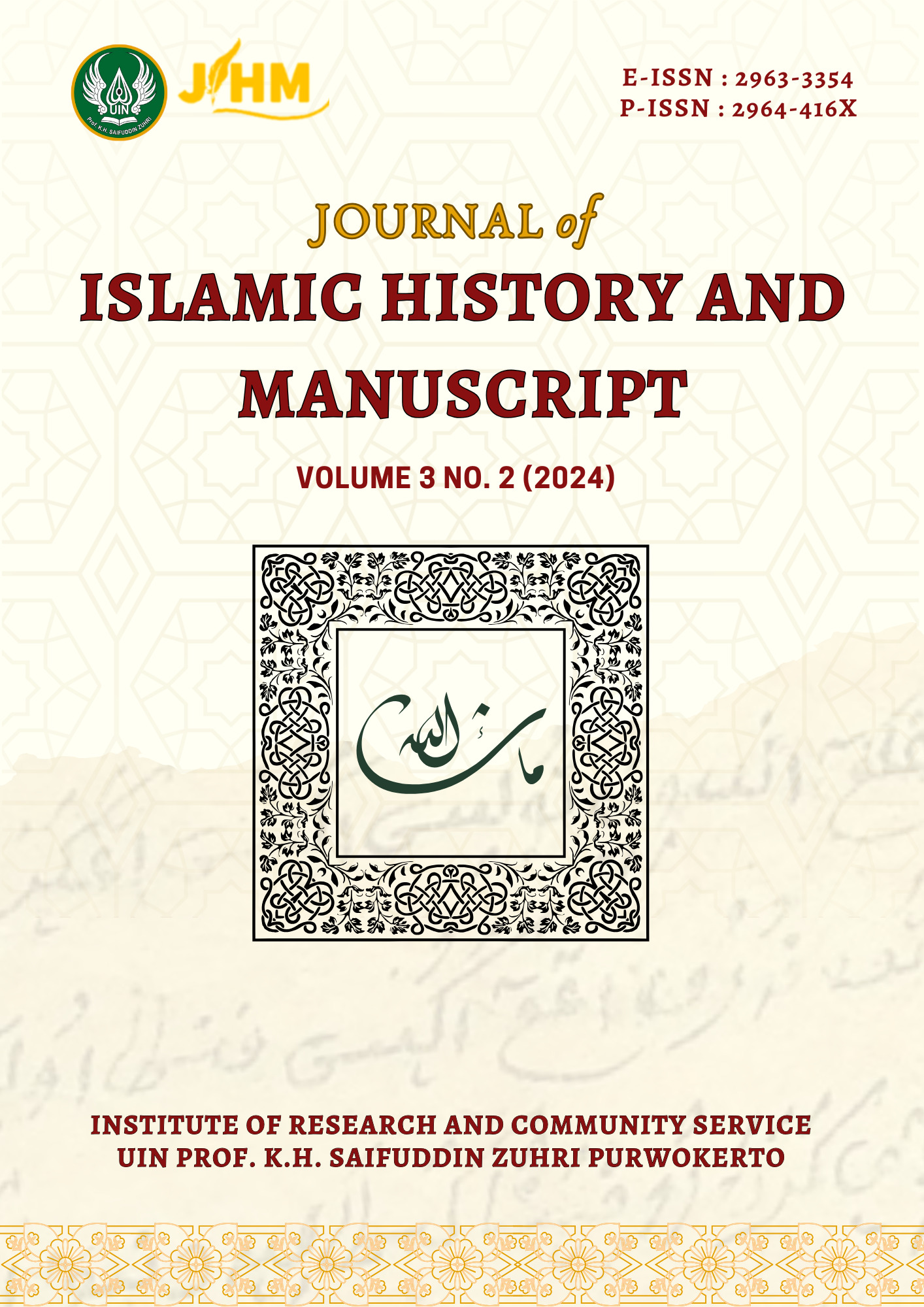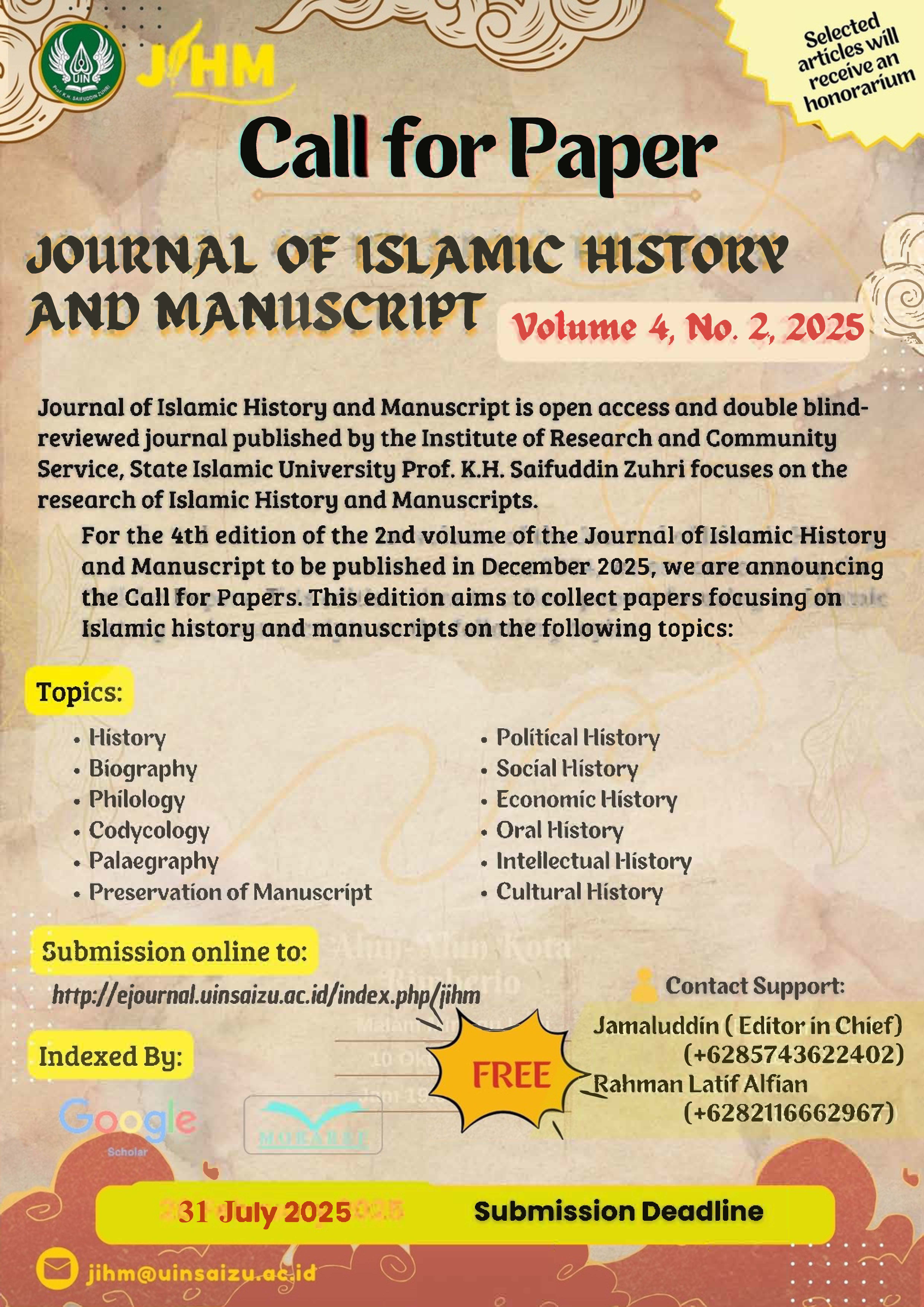Study of Rasm Al-Qur'an: Rasm Analysis of Surah Yasin in the Manuscript of Al-Qur'an Kaji Ngali Badongan, Semin, Gunungkidul
DOI:
https://doi.org/10.24090/jihm.v3i2.12227Keywords:
Manuscript of the Qur'an, Codicology, Textology, Qur'anic Sciences of Surah YasinAbstract
This article examines the Mushaf Al-Qur'an Kaji Ngali Badongan Gunugkidul, Yogyakarta. This privately owned manuscript is kept by Nur Yahman, the manuscript's heir. Historically, the manuscript has two different sources regarding its first copyist. The research focuses on the analysis of the rasm in surah Yasin contained in the Kaji Ngali Badongan manuscript. The method used is content analysis with text analysis and philology with the approach of codicology and textology. The final result of this research shows that the manuscript of Kaji Ngali Badongan Al-Qur'an Mushaf uses simple geometric illumination located at the beginning and middle of the Mushaf. The rasm ilma'i is still applied in the rule of ḥadf al-alif, besides that the rasm used is rasm usmani and Imla'i. Corrupt or unavoidable writing errors include, corrected errors, repeated writing, and lack of verse compositionReferences
Akbar, A. (2010). Khazanah Mushaf Kuno. In Buku Filologi dan Islam Indonesia. Puslitbang Lektur Keagamaan Badan Litbang dan Diklat Kementrian Agama RI Gedung Bayt Al-Qur’an & Museum Istiqlal.
Akbar, A. (2019). Kaligrafi dan Iluminasi dalam Mushaf Al-Qur’an Nusantara dalam Mushaf Kuno Nusantara Jawa. Lajnah Pentashihan Mushaf Al-Qur’an Badan Litbang dan Diklat Kementrian Agama Gedung Bayt Al-Qur’an & Museum Istiqlal.
As-Suyuti, A. F. J. ’Abdirrahman A.-B. (n.d.). Al-Itqan fi ’Ulum al-Qur’an. Dar al-Kutub al-Ilmiyyah.
Baried, S. B. (1985). Pengantar Teori Filologi. Pusat Pembinaan dan Pengembangan Bahasa Departemen Pendidikan dan Kebudayaan.
Faizin, H. (2012). Sejarah Pencetakan Al-Qur’an. Era Baru Pressiondo.
Fathurahman, O. (2010). Filologi Indonesia: Filologi dan Islam Indonesia. Puslitbang Lektur Keagamaan Badan Litbang dan Diklat Kementrian Agama RI Gedung Bayt Al-Qur’an & Museum Istiqlal.
Gusmian, I. (2017). Relasi Kiai dan Penguasa di Surakarta. Suhuf, 10(2). https://doi.org/10.22548/shf.v10i2.273
Mulya, S. R. S. (2016). Naskah-Naskah Scriptorium Pakualaman. Kepustakaan Populer Gramedia.
Mustofa. (2011). Pembakuan Qira’at ’Asim. Suhuf, 4(2).
Mustofa. (2014). Keragaman Qiraat dalam Mushaf Kuno Nusantara (Studi Mushaf Kuno Sultan Ternate). Suhuf, 7(2).
Mustopa, & Madzkur, Z. A. (2020). Mushaf Bahriyah: Sejarah dan Eksistensinya di Indonesia. Suhuf, 13(2). https://doi.org/10.22548/shf.v13i2.578
Niam, K., & Alifah, T. (2023). Manuscript of Mushaf Al-Qur’an KH. Muhammad Ihsan Wonodoyo Gunungkidul (Codicology-Textology Aspect Analysis). JIHM, 2(2). https://doi.org/10.24090/jihm.v2i2.6967
Rahamayani, T. (2017). Karakteristik Manuskrip Mushaf Al-Qur’an H. Abdul Ghaffar di Madura. Nun, 3(2). https://doi.org/10.32495/nun.v3i2.45
Rohmana, A. J. (2018). Empat Manuskrip di Subang Jawa Barat (Studi Kodikologi Manuskrip Al-Qur’an). Jurnal Ilmiah Agama Dan Sosial Budaya, 3(1). https://doi.org/10.15575/jw.v3i1.1964
Rokhmansyah, A. (2017). Teori Filologi. Istana Agency.
Syarifuddin, & Musadad, M. (2015). Beberapa Karakteristik Mushaf Al-Qur’an Kuno Situs Girigajah Gresik. Suhuf, 8(1). https://doi.org/10.22548/shf.v8i1.1
Syatri, J. (2014). Quran Manuscripts at the Museum of the Institute of PTIQ Jakarta. Suhuf, 7(2).
Syatri, J. (2015). Telaah Qiraat dan Rasm pada Mushaf Al-Qur’an Kuno Bonjol dan Payakumbuh. Suhuf, 8(2). https://doi.org/10.22548/shf.v8i2.9
Umirnawati. (2020). Ilustrasi dan Iluminasi dalam Naskah Assikalaibineng: Kajian Semiotika Pierce. Universitas Hasanuddin.
Wahyudi, R. (2020). Penerapan Tarjih Rasm Utsmani & Dhabth Al-Qur’an. Farha Pustaka.
Wardah, S. E. (2012). Kajian Kondisi Fisik dan Seluk Beluk Pernaskahan (Filologi). Tsaqofah, 10(1).
Yahya, M., & Aini, A. F. (2017). Karakteristik dan Fragmen Sejarah Manuskrip Mushaf Dolah Bakri Wonolelo Bantul. Mutawatir: Jurnal Keilmuan Tafsir Hadis, 7(2). https://doi.org/10.15642/mutawatir.2017.7.2.235-262
Downloads
Published
How to Cite
Issue
Section
License
Copyright (c) 2024 Andika Lindra Widyaningsih, Khairun Niam

This work is licensed under a Creative Commons Attribution 4.0 International License.
Authors who publish in this journal agree to the following terms:
- Authors retain copyright and grant the journal right of first publication with the work simultaneously licensed under a Creative Commons Attribution 4.0 International License. that allows others to share the work with an acknowledgment of the work's authorship and initial publication in this journal.
- Authors can enter into separate, additional contractual arrangements for the non-exclusive distribution of the journal's published version of the work (e.g., post it to an institutional repository or publish it in a book), with an acknowledgment of its initial publication in this journal.
- Authors are permitted and encouraged to post their work online (e.g., in institutional repositories or on their website) before and during the submission process, as it can lead to productive exchanges and earlier and greater citation of published work (See The Effect of Open Access).

















